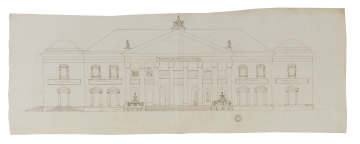Inscribed
Inscribed in ink on architrave The Theatre was Erected by the King, Peers/ & Commoners of Britain in the First Parliament; and in pencil on the pediment Britain presents her Arts/ to the King; and in pencil on the panels between the pilasters Triton/ Orpheus / Charms his beasts/ Orpheus charms Pluto/ dancing / Spring & Con/ versation of / the Muses / Comedy / Dance / of the Muses / Sacrifice of ye muses / Tragedy / Arion/ Arion & the / Dolphin/ Singing / Ampheon/ rules Thebes
Signed and dated
- Undated, probably 1762/63
Medium and dimensions
Pen, pencil
231 x 656
Hand
James Adam
Notes
The first parliament of the reign of George III began in 1760 and this drawing belongs to that period, and is probably contemporary with James Adam's Parliament House scheme of 1762/63; like that scheme it may have been begun before he left London for Italy in 1760. The plan of the theatre is shown in Adam vol.7/171, which in turn is a version of the ink sketch in Adam vol.7/176. The fountains on either side of the entrance portico are derived from the design in Adam vol.7/108 and this reinforces a date of c.1762/63. One fountain is shown in greater detail in Adam vol.7/184. The façade was also to be enriched with a series of relief panels that related to the theatre, whose subjects are suggested in the pencil notes. The four niches on either side of the door were to hold the figures of Dancing, Comedy, Tragedy and Singing. There is a more detailed version of the upper windows in Adam vol.7/172 and 173.
The Adam library contained Carlo Fontana (1634/8–1714)'s compendium of seventeenth-century theatre designs that Robert Adam used for his work at Drury Lane and the Haymarket Opera House, both London.
Level
Drawing
Exhibition history
'Bob the Roman': Heroic Antiquity and the Architecture of Robert Adam, Sir John Soane's Museum, London, 27 June - 27 September 2003; New York School of Interior Design Gallery, 29 September - 4 December 2004
Digitisation of the Drawings Collection has been made possible through the generosity of the Leon Levy Foundation
Sir John Soane's collection includes some 30,000 architectural,
design and topographical drawings which is a very important resource for
scholars worldwide. His was the first architect’s collection to attempt to
preserve the best in design for the architectural profession in the future, and
it did so by assembling as exemplars surviving drawings by great Renaissance
masters and by the leading architects in Britain in the 17th and 18th centuries
and his near contemporaries such as Sir William Chambers, Robert Adam and
George Dance the Younger. These drawings sit side by side with 9,000 drawings
in Soane’s own hand or those of the pupils in his office, covering his early
work as a student, his time in Italy and the drawings produced in the course of
his architectural practice from 1780 until the 1830s.
Browse (via the vertical menu to the left) and search results for Drawings include a mixture of
Concise catalogue records – drawn from an outline list of the collection – and
fuller records where drawings have been catalogued in more detail (an ongoing
process).


